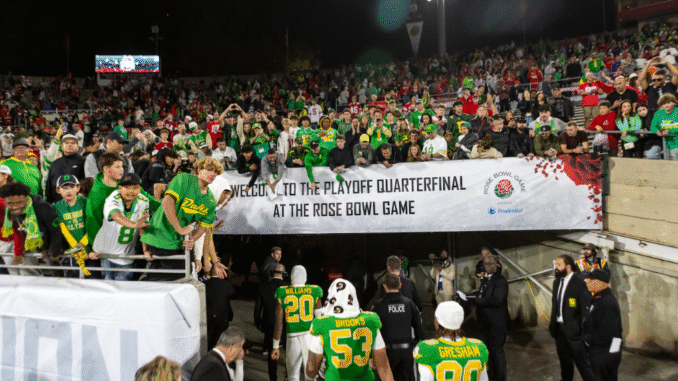
I don’t know if Oregon would have beaten Ohio State if their College Football Playoff clash had come in the national championship game instead of in the Rose Bowl.
Based on what we saw in Pasadena, I’d say probably not.
But I would have liked to find out.
The CFP’s decision Thursday to eliminate automatic byes for the four highest-ranked conference champions is the right one. However, it’s little comfort to the team that suffered the most from the playoff’s learning-on-the-fly approach to the new system.
Too little, too late for the Ducks.
Doesn’t do anything for Dillon Gabriel or Tez Johnson; Jeff Bassa or Terrance Ferguson.
If you apply next year’s seeding to last year’s rankings, in order to reach the title game, the Ducks would have needed to defeat the winner of Boise State-Indiana in the Rose Bowl, and then whichever team emerged from the group of Clemson, Notre Dame and Penn State.
I would have liked the Ducks chances of getting to Atlanta.
That is a more appropriate reward for a team that went 12-0 in the regular season and won a conference championship game than the potential Ohio State-Texas-Georgia path the Ducks were facing in January.
Alas… There probably isn’t much value in relitigating how last season played out. It doesn’t matter now whether the Ducks would have benefitted from something closer to a tune-up in the Rose Bowl before getting into the teeth of the playoff.
Shoot, maybe they would have lost to Boise State or Indiana anyway!
We just don’t know. What’s done is done. The fact is, the Ducks got shellacked 41-21 in Pasadena — and it wasn’t even that close.
Nonetheless, Thursday’s news was probably bittersweet if you’re an Oregon fan.
In short order, Dan Lanning has elevated Oregon to one of the nation’s top programs. The Ducks will be back. But the truly special seasons only come around so often, and for the players on those teams, you never get them back once they’re gone.
Instead of Gabriel it will be Dante Moore at quarterback. And the tight end is Kenyon Sadiq, not Ferguson.
The Ducks will almost certainly start next season in the top-25 with a reasonable path back to the playoff.
The defense turned heads during spring practices and Moore will have a host of experienced receivers to throw to.
But Oregon will have a lot to prove before it can be seen as on the level of the 2024 version, which overcame early struggles to win a conference championship in its first season in the Big Ten.
The CFP got it wrong in Year 1, no question. The Ducks were victims of a system the committee is now owning as flawed. Thank goodness football’s leaders remedied the system’s biggest flaw.
But it is the job of leaders to anticipate pitfalls and to see around corners.
Lanning’s Ducks deserved better than to serve as the lab rats for the CFP’s latest experiment.
It should have been apparent that the four highest-ranked conference champions would not be even close to the top four teams in the polls. Not with the balance of power so dramatically consolidated.
Now, the CFP is talking about expanding to as many as 16 teams in 2026 with the SEC and Big Ten accounting for half the field of automatic qualifiers. I actually like a bigger playoff, even if it does open up the postseason field to more teams that likely have little chance of winning.
But with an entirely new format potentially another year away, you have to wonder what growing pains it will present and what tweaks will have to be made to that one.
And what fanbase will suffer because of it.

Leave a Reply